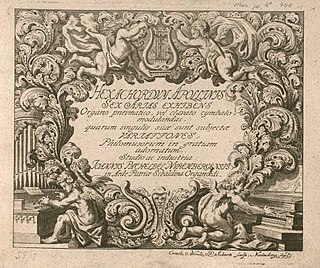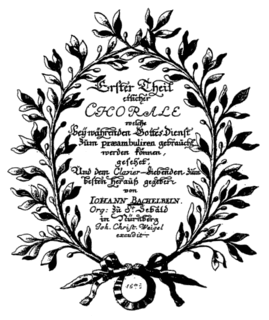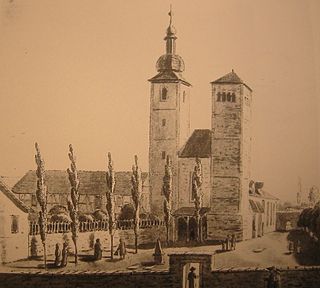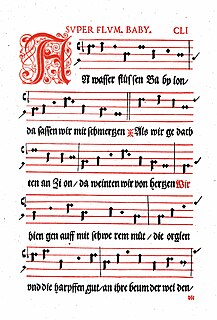Johann Pachelbel was a German composer, organist, and teacher who brought the south German organ schools to their peak. He composed a large body of sacred and secular music, and his contributions to the development of the chorale prelude and fugue have earned him a place among the most important composers of the middle Baroque era.

Dieterich Buxtehude was a Danish-German organist and composer of the Baroque period. His organ works represent a central part of the standard organ repertoire and are frequently performed at recitals and in church services. He composed in a wide variety of vocal and instrumental idioms, and his style strongly influenced many composers, including Johann Sebastian Bach, his student. Today, Buxtehude is considered one of the most important composers in Germany of the mid-Baroque.
The trio sonata is a genre, typically consisting of several movements, with two melody instruments and continuo. Originating in the early 17th century, the trio sonata was a favorite chamber ensemble combination in the Baroque era.

Pachelbel's Canon is an accompanied canon by the German Baroque composer Johann Pachelbel in his Canon and Gigue for 3 violins and basso continuo. It is sometimes called Canon and Gigue in D or Canon in D. Neither the date nor the circumstances of its composition are known, and the oldest surviving manuscript copy of the piece dates from the 19th century.
Wilhelm Hieronymus Pachelbel was a German composer and organist, the elder son of Johann Pachelbel.

Johann Kuhnau was a German polymath, known primarily as composer today. He was also active as a novelist, translator, lawyer, and music theorist, and was able to combine these activities with his duties in his official post as Thomaskantor in Leipzig, which he occupied for 21 years. Much of his music, including operas, masses, and other large-scale vocal works, is lost. His reputation today rests on his Biblical Sonatas, a set of programmatic keyboard sonatas published in 1700, in which each sonata depicted in detail a particular story from the Bible. After his death, Kuhnau was succeeded as Thomaskantor by Johann Sebastian Bach.
Georg Böhm was a German Baroque organist and composer. He is notable for his development of the chorale partita and for his influence on the young J. S. Bach.

The sonatas and partitas for solo violin are a set of six works composed by Johann Sebastian Bach. They are sometimes referred to in English as the sonatas and partias for solo violin in accordance with Bach's headings in the autograph manuscript: "Partia" was commonly used in German-speaking regions during Bach's time, whereas the Italian "partita" was introduced to this set in the 1879 Bach Gesellschaft edition, having become standard by that time. The set consists of three sonatas da chiesa in four movements and three partitas in dance-form movements. The 2nd Partita is widely known for its Chaconne, considered one of the most masterly and expressive works ever written for solo violin.

Passacaglia and Fugue in C minor is an organ piece by Johann Sebastian Bach. Presumably composed early in Bach's career, it is one of his most important and well-known works, and an important influence on 19th and 20th century passacaglias: Robert Schumann described the variations of the passacaglia as "intertwined so ingeniously that one can never cease to be amazed."

Vincent Lübeck was a German composer and organist. He was born in Padingbüttel and worked as organist and composer at Stade's St. Cosmae et Damiani (1675–1702) and Hamburg's famous St. Nikolai (1702–1740), where he played one of the largest contemporary organs. He enjoyed a remarkably high reputation in his lifetime, and had numerous pupils, among which were two of his sons.
Johann Heinrich Buttstett was a German Baroque organist and composer. Although he was Johann Pachelbel's most important pupil and one of the last major exponents of the south German organ tradition, Buttstett is best remembered for a dispute with Johann Mattheson.

Fiori musicali is a collection of liturgical organ music by Girolamo Frescobaldi, first published in 1635. It contains three organ masses and two secular capriccios. Generally acknowledged as one of Frescobaldi's best works, Fiori musicali influenced composers during at least two centuries. Johann Sebastian Bach was among its admirers, and parts of it were included in the celebrated Gradus ad parnassum, a highly influential 1725 treatise by Johann Joseph Fux which was in use even in the 19th century.
Johann Krieger was a German composer and organist, younger brother of Johann Philipp Krieger. Born in Nuremberg, he worked at Bayreuth, Zeitz, and Greiz before settling in Zittau. He was one of the most important keyboard composers of his day, highly esteemed by, among others, George Frideric Handel. A prolific composer of church and secular music, he published several dozen of his works, and others survive in manuscript. However, hundreds more were lost when Zittau was destroyed by fire in 1757, during the Seven Years' War.

Hexachordum Apollinis is a collection of keyboard music by Johann Pachelbel, published in 1699. It comprises six arias with variations, on original themes, and is generally regarded as one of the pinnacles of Pachelbel's oeuvre. The collection includes a preface in which Pachelbel dedicates the work to Dieterich Buxtehude and Ferdinand Tobias Richter and briefly discusses the nature of music.

Erster Theil etlicher Choräle is a collection of liturgical organ music by Johann Pachelbel, published during his lifetime. It contains eight chorale preludes in seven different styles.

Andreas Armsdorff was a German composer and organist. He was born in Mühlberg, near Gotha, and studied music and law. At some point in his early life he moved to nearby Erfurt where he may have studied with Johann Pachelbel. He worked as organist in various churches in Erfurt: Reglerkirche, Andreaskirche, and Kaufmannskirche. He died in Erfurt at the age of 29.
Musicalische Ergötzung is a collection of chamber music by Johann Pachelbel. Published during his lifetime, it contains six suites for two violins and basso continuo.
Chaconne in D minor is an organ chaconne by Johann Pachelbel. It is one of the six surviving chaconnes by the composer, and one of his best known organ works.
Daniel Erich was a German organist and composer.

"An Wasserflüssen Babylon" is a Lutheran hymn by Wolfgang Dachstein, which was first published in Strasbourg in 1525. The text of the hymn is a paraphrase of Psalm 137. Its singing tune, which is the best known part of the hymn and Dachstein's best known melody, was popularised as chorale tune of Paul Gerhardt's 17th-century Passion hymn "Ein Lämmlein geht und trägt die Schuld". With this hymn text, Dachstein's tune is included in the Protestant hymnal Evangelisches Gesangbuch.











